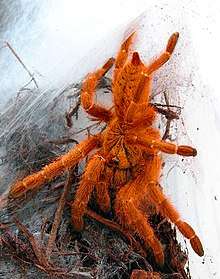Pterinochilus murinus
Pterinochilus murinus, is an old-world tarantula that was first described in 1897 by Reginald Innes Pocock.[1] This species is found on the African continent, in Angola, as well as central, eastern, and southern Africa. It is a member of the subfamily Harpactirinae, baboon spiders.[2]
| Pterinochilus murinus | |
|---|---|
 | |
| Scientific classification | |
| Kingdom: | Animalia |
| Phylum: | Arthropoda |
| Subphylum: | Chelicerata |
| Class: | Arachnida |
| Order: | Araneae |
| Infraorder: | Mygalomorphae |
| Family: | Theraphosidae |
| Genus: | Pterinochilus |
| Species: | P. murinus |
| Binomial name | |
| Pterinochilus murinus | |
| Synonyms[1] | |
| |
Among those who keep tarantulas as pets Pterinochilus murinus is known as "OBT", which means "orange baboon tarantula" or "orange bitey thing" and also as the "pterror", a pun on its Latin genus classification: Pterinochilus. These nicknames reference a particular orange colour form that is prized in the hobby for its beauty and confrontational personality. It is also known as the Mombasa golden starburst tarantula.
This species is incredibly defensive and, as with most old world tarantulas, should not be held. The bite of this species, while not serious, is extremely painful. Moreover, the species is more than willing to inflict such a bite before presenting the typical threat display. Caution when dealing with this species is advised.
Description
Female P. murinus can grow to 4–6 inches (10-15cm) in size (measured from the tip of the front left leg, to the tip of the rear right leg), while males typically range from 3–4 inches (7.5-10cm). The spider's abdomen, carapace, and legs have the same basic coloration, though the legs typically have brightly colored rings. The carapace has a star-shaped pattern, with a fishbone pattern present on the abdomen. The eyes are clustered together on a raised part of the carapace (in common with all tarantulas). The body is covered with short hairs, with longer hair present on the legs. Urticating hairs are not present.
There are currently 5 known colour variants of Pterinochilus murinus: and also localities of those as listed after the color form names.
- BCF - Brown Colour Form - Tete, Mozambique
- DCF - Dark Colour Form - Botswana/Zimbabwe, Kenya, Kigoma, Mikumi
- OCF - Orange Colour Form - Usambara Mountains Region (used to be called UMW before RCF was found)
- RCF - Red Colour Form - Usambara Mountains Region
- TCF - Typical Colour Form - Kenya, Mozambique
These colour variants are found in different geographical locations, and the colouration is thought to be related to the type of soil present where each variant lives.
Distribution
Pternochilus murinus is found in different parts of Africa and has also been recorded on the island of Zanzibar.
Behavior
The orange baboon tarantula is very defensive, and will bite immediately if provoked. Consequently, it is not recommended that hobbyists keep this species without extensive prior experience handling venomous spiders.
The female excavates a burrow, or colonizes an existing burrow that has been abandoned.
As pets
These spiders are not common in pet stores but are very popular in the pet trade. These spiders build a tunnel shaped web and as adults should be provided around 20 cm of substrate. They are commonly fed crickets, cockroaches, and grasshoppers. Though they can kill small vertebrates (mice, small lizards, birds, snakes), these feeder animals are not commonly used in captive care.
These spiders can be very defensive and are believed to have a very painful bite. Although their venom is not known to be lethal to humans, it is considered medically significant and thus it is advised to avoid handling this species.[3]
References
- "Taxon details Pterinochilus murinus (Pocock, 1897)". World Spider Catalog. Natural History Museum Bern. Retrieved 2018-08-06.
- "Pterinochilus murinus". Theraphosidae. 2015-08-23. Retrieved 2020-05-30.
- Ahmed, N.; Pinkham, M.; Warrell, D.A. (2009-09-23). "Symptom in search of a toxin: muscle spasms following bites by Old World tarantula spiders (Lampropelma nigerrimum, Pterinochilus murinus, Poecilotheria regalis) with review". QJM. 102 (12): 851–857. doi:10.1093/qjmed/hcp128. ISSN 1460-2725. PMID 19776152.
| Wikimedia Commons has media related to Pterinochilus murinus. |